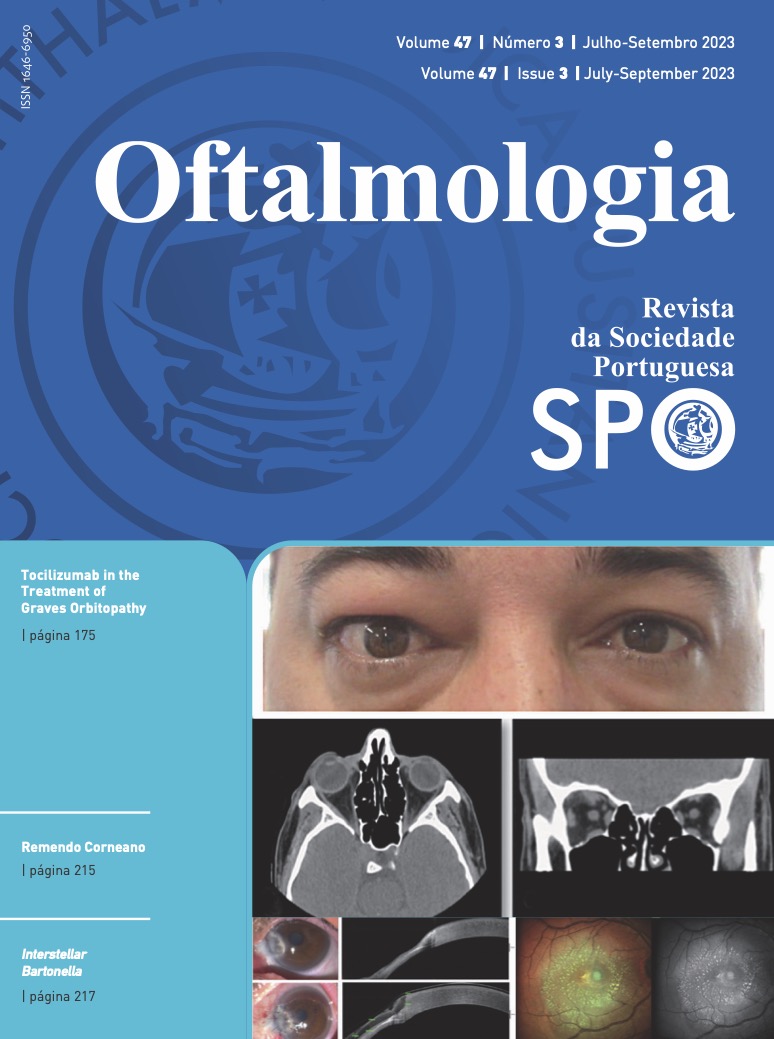Myopia, Axial Length and Lens Thickness: A Corneal Biomechanical Analysis of Older Children and Adolescents
DOI:
https://doi.org/10.48560/rspo.28265Keywords:
Adolescent, Axial Length, Eye, Child, Cornea, Eye/growth & development, Lens, Crystalline, MyopiaAbstract
Introduction: Our objective was to compare the corneal biomechanics of myopes with non-myopes in a sample of Portuguese children. In addition, we sought to evaluate their habits and background as well as to assess the potential relationship of axial length and lens thickness with their corneal biomechanical properties. Methods: Observational cross-sectional study assessing healthy children (8 to 18 years old) conducted at a tertiary university hospital center (Centro Hospitalar Universitário do Porto, Porto, Portugal). Demographic and clinical data were retrieved from medical records and participants’ and parents’ interview. After this interview, ocular biometry and corneal biomechanics were assessed using ZEISS IOL Master 700 (Carl Zeiss Meditec, Jena, Germany) and Corvis ST (Oculus, Wetzlar, Germany), respectively. Linear mixed-effects models adjusting for age and gender were built to assess the relationship between corneal biomechanical properties and myopia, axial length (AL) and lens thickness (LT). Results: One hundred and fifty-six eyes (out of 78 children) were enrolled of which 100 had a spherical equivalent ≤ -0.50 and were classified as myopes. The mean±standard deviation age was 14.18±2.60 years, being significantly higher in the myopes (p=0.004). The proportion of myopes increased with age (p=0.019). LT presented a significant but weak negative correlation with intraocular pressure (r=-0.227, p=0.005). Almost half of myopes had a positive family history of myopia. Non-myopes presented a trend for a higher proportion of atopy (p=0.059) and a significantly higher proportion of dermatitis history (p=0.030). Myopia was associated with higher amplitude of whole eye movement (p<0.001). Longer AL and thinner lenses were associated with a more deformable corneal behavior. Conclusion: In this sample of Portuguese children, AL and LT, but not myopic status, were related with corneal biomechanical behavior. Longitudinal studies are warranted to elucidate the role of corneal biomechanics in the screening and follow-up of ocular diseases in children.Downloads
References
Holden BA, Fricke TR, Wilson DA, Jong M, Naidoo KS, Sankaridurg P, Wong TY, Naduvilath TJ, Resnikoff S. Global Prevalence of Myopia and High Myopia and Temporal Trends from 2000 through 2050. Ophthalmology. 2016;123:1036-42. doi:10.1016/j.ophtha.2016.01.006
Recko M, Stahl ED. Childhood myopia: epidemiology, risk factors, and prevention. Mo Med. 2015;112:116-21.
ChenS,GuoY,HanX,YuX,ChenQ,WangD,ChenX,JinL, Ha J, Li Y, et al. Axial Growth Driven by Physical Development and Myopia among Children: A Two Year Cohort Study. J Clin Med. 2022;11. doi:10.3390/jcm11133642
Shih YF, Chiang TH, Lin LL. Lens thickness changes among schoolchildren in Taiwan. Invest Ophthalmol Vis Sci. 2009;50:2637-44. doi:10.1167/iovs.08-3090
Gwiazda J, Norton TT, Hou W, Hyman L, Manny R, Group C. Longitudinal Changes in Lens Thickness in Myopic Children Enrolled in the Correction of Myopia Evaluation Trial (COMET). Curr Eye Res. 2016;41:492-500. doi:10.3109/0271368 3.2015.1034372
Hon Y, Lam AK. Corneal deformation measurement using Scheimpflug noncontact tonometry. Optom Vis Sci. 2013;90:e1-8. doi:10.1097/OPX.0b013e318279eb87
Yu AY, Shao H, Pan A, Wang Q, Huang Z, Song B, et al. Corneal biomechanical properties in myopic eyes evaluated via Scheimpflug imaging. BMC Ophthalmol. 2020;20:279. doi:10.1186/s12886-020-01530-w
Sedaghat MR, Momeni-Moghaddam H, Azimi A, Fakhimi Z, Ziaei M, Danesh Z, et al. Corneal Biomechanical Properties in Varying Severities of Myopia. Front Bioeng Biotechnol. 2020;8:595330. doi:10.3389/fbioe.2020.595330
He M, Ding H, He H, Zhang C, Liu L, Zhong X. Corneal biomechanical properties in healthy children measured by corneal visualization scheimpflug technology. BMC Ophthalmol. 2017;17:70. doi:10.1186/s12886-017-0463-x
Momeni-Moghaddam H, Hashemi H, Zarei-Ghanavati S, Ostadimoghaddam H, Yekta A, Aghamirsalim M, et al. Four- year changes in corneal biomechanical properties in children. Clin Exp Optom. 2019;102:489-95. doi:10.1111/cxo.12890
Tang SM, Zhang XJ, Yu M, Wang YM, Cheung CY, Kam KW, et al. Association of Corneal Biomechanics Properties with Myopia in a Child and a Parent Cohort: Hong Kong Children Eye Study. Diagnostics. 2021;11. doi:10.3390/diagnostics11122357
Wan K, Cheung SW, Wolffsohn JS, Orr JB, Cho P. Role of corneal biomechanical properties in predicting of speed of myopic progression in children wearing orthokeratology lenses or single-vision spectacles. BMJ Open Ophthalmol. 2018;3:e000204. doi:10.1136/bmjophth-2018-000204
Pult H, Wolffsohn JS. The development and evaluation of the new Ocular Surface Disease Index-6. Ocul Surf. 2019;17:81721. doi:10.1016/j.jtos.2019.08.008
Kenia VP, Kenia RV, Pirdankar OH. Age-related variation in corneal biomechanical parameters in healthy Indians. Indian J Ophthalmol. 2020;68:2921-9. doi:10.4103/ijo.IJO_2127_19
Baptista PM, Marta AA, Marques JH, Abreu AC, Monteiro S, Meneres P, et al. The Role of Corneal Biomechanics in the Assessment of Ectasia Susceptibility Before Laser Vision Correction. Clin Ophthalmol. 2021;15:745-58. doi:10.2147/OPTH. S296744
Salomao MQ, Hofling-Lima AL, Gomes Esporcatte LP, Lopes B, Vinciguerra R, Vinciguerra P, et al. The Role of Corneal Biomechanics for the Evaluation of Ectasia Patients. Int J Environ Res Public Health. 2020;17. doi:10.3390/ijerph17062113
Asano S, Asaoka R, Yamashita T, Aoki S, Matsuura M, Fujino Y, et al. Correlation Between the Myopic Retinal Deformation and Corneal Biomechanical Characteristics Measured With the Corvis ST Tonometry. Transl Vis Sci Technol. 2019;8:26. doi:10.1167/tvst.8.4.26
Zhang H, Eliasy A, Lopes B, Abass A, Vinciguerra R, Vinciguerra P, et al. Stress-Strain Index Map: A New Way to Represent Corneal Material Stiffness. Front Bioeng Biotechnol. 2021;9:640434. doi:10.3389/fbioe.2021.640434
Salvetat ML, Zeppieri M, Tosoni C, Felletti M, Grasso L, Brusini P. Corneal Deformation Parameters Provided by the Corvis-ST Pachy-Tonometer in Healthy Subjects and Glaucoma Patients. J Glaucoma. 2015;24:568-74. doi:10.1097/IJG.0000000000000133
Vinciguerra R, Rehman S, Vallabh NA, Batterbury M, Czanner G, Choudhary A, et al. Corneal biomechanics and biomechanically corrected intraocular pressure in primary open-angle glaucoma, ocular hypertension and controls. Br J Ophthalmol. 2020;104:121-6. doi:10.1136/bjophthalmol-2018-313493
Eliasy A, Chen KJ, Vinciguerra R, Lopes BT, Abass A, Vinciguerra P, et al. Determination of Corneal Biomechanical Behavior in-vivo for Healthy Eyes Using CorVis ST Tonometry: Stress-Strain Index. Front Bioeng Biotechnol. 2019;7:105. doi:10.3389/fbioe.2019.00105
Williams KM, Verhoeven VJ, Cumberland P, Bertelsen G, Wolfram C, Buitendijk GH, et al. Prevalence of refractive error in Europe: the European Eye Epidemiology (E(3)) Consortium. Eur J Epidemiol. 2015;30:305-15. doi:10.1007/s10654-015- 0010-0
Kim H, Seo JS, Yoo WS, Kim GN, Kim RB, Chae JE, et al. Fac- tors associated with myopia in Korean children: Korea National Health and nutrition examination survey 2016-2017 (KNHANES VII). BMC Ophthalmol. 2020;20:31. doi:10.1186/s12886-020-1316-6
Mutti DO, Mitchell GL, Moeschberger ML, Jones LA, Zadnik K. Parental myopia, near work, school achievement, and children’s refractive error. Invest Ophthalmol Vis Sci. 2002;43:3633-40.
Gilaberte Y, Perez-Gilaberte JB, Poblador-Plou B, Bliek-Bueno K, Gimeno-Miguel A, Prados-Torres A. Prevalence and Comorbidity of Atopic Dermatitis in Children: A Large-Scale Population Study Based on Real-World Data. J Clin Med. 2020;9:1632. doi:10.3390/jcm9061632
Tideman JW, Polling JR, Voortman T, Jaddoe VW, Uitterlinden AG, Hofman A, et al. Low serum vitamin D is associated with axial length and risk of myopia in young children. Eur J Epidemiol. 2016;31:491-9. doi:10.1007/s10654-016-0128-8
Han SB, Jang J, Yang HK, Hwang JM, Park SK. Prevalence and risk factors of myopia in adult Korean population: Korea national health and nutrition examination survey 2013-2014 (KNHANES VI). PloS One. 2019;14:e0211204. doi:10.1371/journal.pone.0211204
Saw SM, Carkeet A, Chia KS, Stone RA, Tan DT. Compo- nent dependent risk factors for ocular parameters in Singapore Chinese children. Ophthalmology. 2002;109:2065-71. doi:10.1016/s0161-6420(02)01220-4
Arunthavaraja M, Vasudevan B, Ciuffreda KJ. Nearwork- induced transient myopia (NITM) following marked and sustained, but interrupted, accommodation at near. Oph- thalmic Physiol Opt. 2010;30:766-75. doi:10.1111/j.1475-1313.2010.00787.x
Zadnik K, Mutti DO, Fusaro RE, Adams AJ. Longitudinal evidence of crystalline lens thinning in children. Invest Ophthalmol Vis Sci. 1995;36:1581-7.
Saw SM, Chua WH, Gazzard G, Koh D, Tan DT, Stone RA. Eye growth changes in myopic children in Singapore. Br J Ophthalmol. 2005;89:1489-94. doi:10.1136/bjo.2005.071118
Wong HB, Machin D, Tan SB, Wong TY, Saw SM. Ocular component growth curves among Singaporean children with different refractive error status. Invest Ophthalmol Vis Sci. 2010;51:1341-7. doi:10.1167/iovs.09-3431
Mutti DO, Zadnik K, Fusaro RE, Friedman NE, Sholtz RI, Adams AJ. Optical and structural development of the crystalline lens in childhood. Invest Ophthalmol Vis Sci. 1998;39:120-33.
Silva N, Ferreira A, Baptista PM, Figueiredo A, Reis R, Sampaio I, et al. Corneal Biomechanics for Ocular Hypertension, Primary Open-Angle Glaucoma, and Amyloidotic Glaucoma: A Comparative Study by Corvis ST. Clin Ophthalmol. 2022;16:71-83. doi:10.2147/OPTH.S350029
Dascalescu D, Corbu C, Vasile P, Iancu R, Cristea M, Ionescu C, et al. The importance of assessing corneal biomechanical properties in glaucoma patients care - a review. Rom J Ophthalmol. 2016;60:219-25.
Downloads
Published
How to Cite
Issue
Section
License
Copyright (c) 2023 Revista Sociedade Portuguesa de Oftalmologia

This work is licensed under a Creative Commons Attribution-NonCommercial 4.0 International License.
Do not forget to download the Authorship responsibility statement/Authorization for Publication and Conflict of Interest.
The article can only be submitted with these two documents.
To obtain the Authorship responsibility statement/Authorization for Publication file, click here.
To obtain the Conflict of Interest file (ICMJE template), click here





